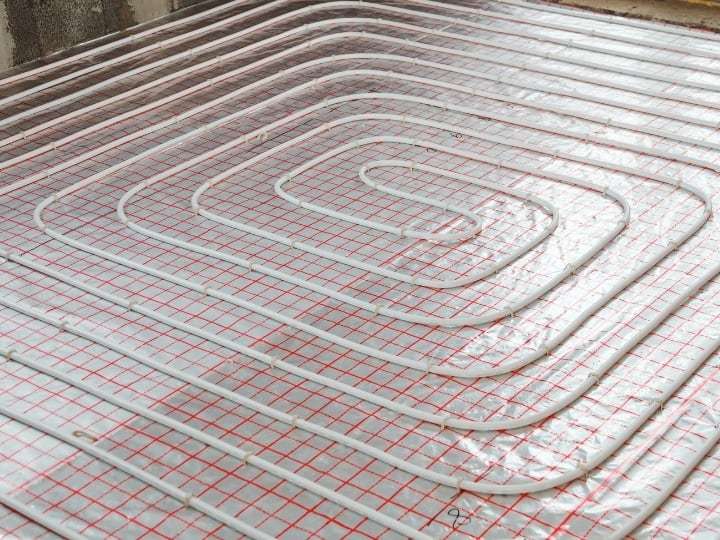If you are looking for a green-energy way to heat your home or outbuildings, you might wonder if you can use solar power as the power source for underfloor heating.
Quite simply, you can. However, there are some essential bits that you will need to know before adding solar as your energy source for underfloor heating systems.
We already know solar panels can power underfloor heating, but there is a right and wrong ways to go about that process. The good news is that we sort that out for you in this blog.
In this blog, we discuss
- Whether you can use solar panels to power an underfloor heating system.
- The two types of underfloor heating systems and how they differ
- What is the best underfloor heating system, and why

Can solar panels run underfloor heating?
Solar energy can run underfloor heating. The big question here is whether you mean, “can solar power heat the water for underfloor heating,” or do you mean can solar power directly heat underfloor heating systems?
There are two ways of powering the underfloor heating. They are:
A holding tank is full of water and then heated, forcing the water through a system of pipes under the floor. The heat transfer causes the underfloor space to heat and radiates through a solid surface.
In this case, solar energy would be the power source that heated the water in the storage tank.
You could use solar energy to do this, but it is not very efficient, and it could lead to issues such as insufficient or reserved power (battery depletion.)
The other option is to use an electric mat that you power directly from the solar array. The process is more efficient than heating water and is much faster.
The electric mat is built into the subfloor or the floor itself and then backed with materials that cause the heat to radiate to the floor.
- LUXURY AND COMFORT - Enjoy the Warmth of LuxHeat's easy-to-install Electric Floor Heating System. Our In Floor Heating Kit...
- EASY TO INSTALL - The 3" Pre-spaced Electric Floor Heating Mat can be cut & turned, flipped or rotated - providing warmth...
- QUALITY & EXPERIENCE - With an overall experience of 50 years in the floor heating industry, the LuxHeat team offers a wide...

How Does Solar Underfloor Heating Work?
As we described above, two methods of creating radiant heating for floors exist. The first is to pump hot water through pipes under the floor. The second is to use electricity to heat a wire mat which then radiates heat.
Indirect heating, the hot water method, is an inferior energy use. Water is a sink for energy.
- You can think about a hurricane. For a hurricane to form, the water must reach 80°F at 200 feet deep. That’s a lot of heat.
The same is true when you heat water stored in a container. It takes a lot of energy to heat 500 gallons of water, especially when the weather outside is cold. You would need a significant amount of solar energy.
That means your solar array would need to be overly large with battery backup systems that could handle the extra energy needed to heat the water to heat the floor.

Direct heating, the electric mat method, takes less energy to run it. You could shuttle excess energy from your solar array into the floor mat to power it since that energy would be wasted if not consumed.
The solar array would be smaller than one that usage included heating water. The battery backup supply would also be smaller since less energy is needed.
The solar circuit, which moves energy from the panels to the controller, the batteries, the inverter, and then to the house, often has extra energy if the batteries are full.
That energy either goes into the utility grid or dissipates and is wasted. When you use a direct method to power an underfloor heating system, you have the opportunity to use energy that you would otherwise be wasting to power the floor heating system.
So, in a way, you are making the world greener when you go with a direct source over an indirect source of power for underfloor heating units.

See also: What is Solar Heating? A Comprehensive Guide to Harnessing the Sun’s Power
Can solar panels be used for heating?
You can use the energy from solar panels to create heat for a home or business.
Heating a home and cooling a home are two of the most significant usages of energy, and solar energy is a very green way to power both heating and cooling.
The positive is that using solar energy to heat or cool your home or business significantly drops your monthly power bill.
Solar energy can heat your home if you use underfloor heating systems or a conventional HVAC.
However, it would be essential to include a battery backup system with enough batteries to power the home’s standard energy requirements and an underfloor heating system.

What Is The Best Heating System For Underfloor Heating?
The direct heating source is better for the two types of underfloor heating systems we discuss here. If you live in a mild climate, either method may be okay.
However, in terms of energy use, the direct heating method is by far more efficient.
The benefits of using a direct heating system include:
- Smaller Solar Array Requirements — You do not need as many solar panels to run a direct underfloor heating system because there is lower energy usage.
- More applicable on cloudy days due to the lower energy requirements — On cloudy days, there is less incoming solar radiation which means the solar array produces less energy. With the direct underfloor heating system, you would likely still have the energy to power the system, even on cloudy days.
- Decrease in Annual Energy Usages — Because the system uses less energy than an indirect underfloor heating system, your household uses less energy annually with a direct underfloor heating system.
Indirect or Direct Heating using Solar
Other considerations make deciding between an indirect underfloor heating system and one that uses direct energy.
Climate
In milder climates, either system works well; you will have to utilize more energy to heat the water in an indirect underfloor heating system than you would with a direct system.
On the other hand, if you live in a colder climate, you would use more energy each year, heating the water in the indirect underfloor heating system.
That can be problematic if the cooler months have more clouds, storms, or snow.
Solar Array Size
You could use either method to heat your home if you have a large solar array.
If you have a smaller array, you would want to use the direct heating underfloor heating system because the energy demands are much smaller than the indirect heating system.
Another consideration here is the amount of wasted energy that your array produces. If there is a lot of wasted energy, you could utilize it for an underfloor heating system (Indirect) with water tubes and a reservoir.
Grid-tied vs. Off-Grid
With an off-grid solar array, your energy is limited by how much energy the array produces, the number of solar batteries in your energy storage system, and how much energy your home requires.
A direct power underfloor heating system would be best for off-grid or mobile living situations (caravan.)
If grid-tied, you could use either system, though you’d likely pay more money each month to the utility company if you went with an indirect underfloor heating system.
Sources




